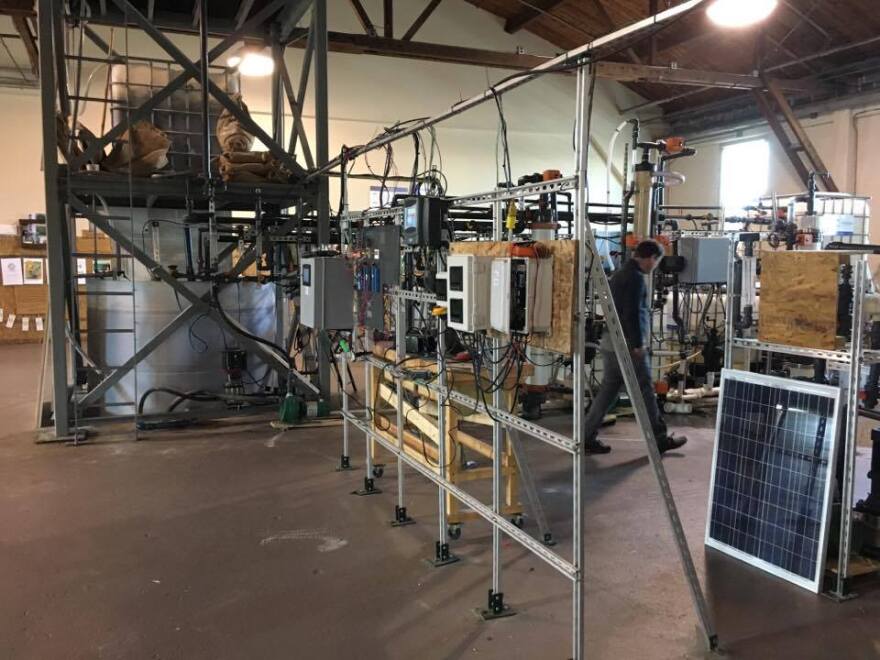Water Mission is a non-profit based in Charleston focused on helping developing nations restore access to clean water, particularly following natural disasters. The group has projects around the world including Peru, Indonesia, and Kenya. In 2015, they used their purifying technology to help a city closer to home: Columbia. Cooper McKim has the story.
Just north of Charleston, Water Mission is headquartered in a warehouse. The offices inside seem expansive, with employees milling around their shared work spaces looking much like a start-up. At one end of the quiet office, an unimposing door leads to the massive, high-ceilinged center of Water Mission's innovation -- the laboratory.

On one side are metal frames embedded with purifying technology the group is testing. It's layered with boxes, wires, wood, and pipes that lead to vats of chemically unique water. Seth Womble, VP of Operations says, "we're trying to simulate what it would be like in a developing country with different source water contaminants and also long-term operation."
Water Mission restores clean water by using technologies like this. Some are manufactured elsewhere, some here. Womble says with each new location the first step is developing a new water source: "we take that water, we test it for contaminants, we treat it specifically for those contaminants, and then we distribute it out through the community."

One example of their work was in Haiti in 2010. When the earthquake struck, Womble knew there was already minimal infrastructure to support clean water. He says the destruction of existing latrines and water lines could cause an outbreak of cholera, "and so there's a huge urgency to get in there quickly and to mitigate future risk of water-borne illness after the disaster."
In fact, Womble says there were 6000 cholera-related deaths out of every 200,000 people in Haiti after the 2010 earthquake.
Water Missions has done projects in 53 countries with a full-time staff in nine of them. Womble puts it simply: "our mission is to provide safe water and the opportunity to experience the love of god in all our projects."
"It's a hard ten days, but it was a great ten days."
The group typically stays out of the United States due to the other safety nets that exist here. Citizens are more likely to be able to boil water, drive or take public transportation, buy bottled water or appeal to organizations like the Red Cross or FEMA. Plus, if Water Mission did want to provide water to U.S. communities, there's the regulatory challenge of having their technology signed off by the local health and environmental agency.

Still, in 2015, Water Mission broke with tradition. A flood of massive proportions ripped apart Columbia in October of 2015. The canal keeping the Congaree River at bay was breached causing massive utilities outages. At the same time, road collapses were breaking water transport lines opening them up to contamination. Overall, 40,000 people in the greater Columbia lost access to water.
Despite their past, Womble says it was clear decision for the organization: "It just happened to be though, we're in South Carolina - we started there first. We were ready to go."

They transported five reverse Osmosis systems up to Columbia days after the storm setting up shop near the center of town. Several above-ground pools connected to bladders, or soft-shelled tanks; all of it was a part of the reverse osmosis system working to produce approximately 10,000 gallons of clean water per day.
Air Force Veteran and Columbia-native Bob McNaughton was one of the volunteers helping out that day. He and his wife, Beth, had just returned to the U.S. after spending over a year in Africa volunteering with Water Mission. He says, "we never thought that we'd need to do this here. We were blown away. We came back in August, talked about our great water, and sure enough we had a water crisis."
McNaughton worked to help set up distribution sites around the city. In the process, he met a lot of people who were hurting. Many were clearly relieved to have someone to confide in. “Some of those tears was a combination of the flood and ‘people don’t know how bad I’m hurtin,’" he says.

His wife Beth volunteered as well. She remembers seeing the need firsthand for clean water in Columbia. At one point, she was going door-to-door informing people of the clean water nearby -- one woman was very relieved to meet them.
She says, "we ran into one woman had just had surgery. She wasn't able to drive. She lived alone, and she had a neighbor who had brought her some water, but she was running out." So Beth and the other volunteers regularly brought her water throughout the week.
Her husband Bob says one of the biggest challenges was getting the water to people, though. Few knew to bring jugs when they visited distribution sites. Others weren't sure why the volunteers were there at all. Nevertheless, he says it's something special to be able to lend a hand right in your backyard.
McNaughton says, "it's a hard days, but it was a great ten days."



